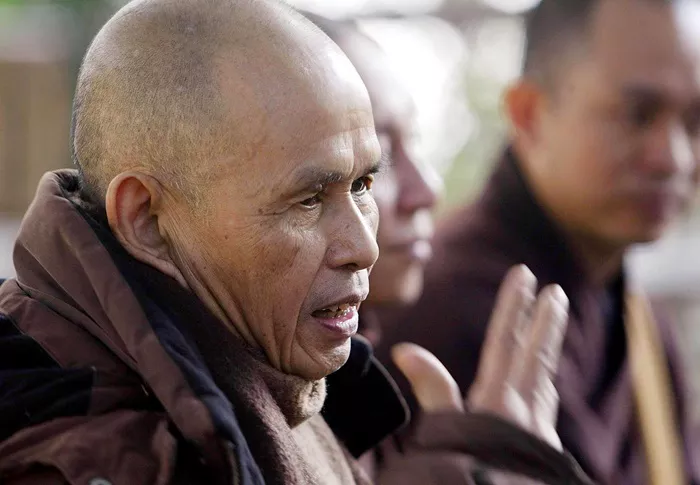When you are angry, close your eyes, close your ears, and go back to yourself to calm your anger. Smile, even if it takes effort. Smiling relaxes hundreds of tiny muscles and makes your face more attractive. Sit down and observe deeply wherever you are.
If your concentration is not strong enough, go outside and practice walking meditation. The most important thing is to water the seed of mindfulness and let it arise in your consciousness.
Mindfulness is always mindfulness of something, just as anger is always anger at something. When you drink a glass of water and are aware that you are drinking a glass of water, this is mindfulness of drinking water. In this case, we have arisen mindfulness of anger.
“Breathing in, I know that I am angry. Breathing out, I know that anger is in my heart.” First, the energy of anger arises, and second, the energy of mindfulness arises. The second energy embraces the first energy to soothe it and calm it.
We cultivate mindfulness not to drive away or fight anger, but to deal with it properly. This approach is non-dualistic and non-violent. It is non-dual because it recognizes that both mindfulness and anger are part of who we are. One energy embraces the other. Don’t get angry at your anger.
Don’t try to push it away or suppress it. Acknowledge that it has arisen and deal with it. When your stomach hurts, don’t get angry at it. Take care of it.
When a mother hears her baby crying, she drops her work, picks up the baby, and comforts her. Then she tries to understand why the baby is crying, whether it’s because of physical or emotional discomfort.
Look deeply at your anger, as you would at your own child. Don’t reject it, and don’t hate it. Meditation is not about turning yourself into a battlefield, pitting one against the other. Conscious breathing soothes and calms anger, and mindfulness penetrates it.
Fifteen minutes after you turn on the heater, and the warm air fills the cold room, transformation has occurred. You don’t need to discard or suppress anything, not even your anger. Anger is just an energy, and all energy can be transformed.
Meditation is the art of transforming one energy into another. The moment the mother holds her child, the child feels the energy of love and comfort and begins to feel relieved. Even if the source of discomfort is still there, being mindful is enough to bring some relief.
In the Anapanasati Sutta (Omniscience of the Breath), the Buddha taught: “I breathe in and calm the activity of the mind.” “The activity of the mind” refers to any emotion or mental state, such as anger, sadness, jealousy, or fear. When you breathe mindfully, you embrace and calm that mental state.
As soon as you realize that anger has arisen, arise mindfulness to embrace it. After ten minutes, the intensity of the anger will decrease, and mindfulness will reveal many things. The mother holds the child for a few minutes, perhaps humming a lullaby, and then looks for the cause of the child’s discomfort.
Maybe the baby has a fever or a cold, maybe the diaper is too tight, or she is thirsty. Once the mother finds the cause, she can immediately turn the situation around. It is important to find the root of the problem. This is the practice of deep observation.
“As I breathe in, I know that I am angry. As I breathe out, I know that anger is in me.” First, you practice cognition. “Hello, anger, my old friend.” Then you look deeper, looking for its root. “Why am I angry?”
You first discover that your suffering is rooted in your store consciousness, in pre-existing seeds, seeds of anger, delusion, pride, doubt or greed. Other people are only secondary causes.
Then you discover that the other person is suffering too. You may think you are the only one suffering, but you are not. When someone pours the same pain into you, you know that he is suffering too. When you understand this, love wells up in your heart and you want to help. Understanding is the key.
Thanks to the practice of mindfulness, your anger will return to your store consciousness. The next time anger arises, practice in the same way, and eventually the seeds of anger in you will weaken. This is the practice of facing anger directly, and, thanks to mindfulness, it can transform it into the energy of love and understanding.

